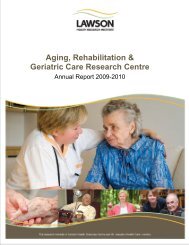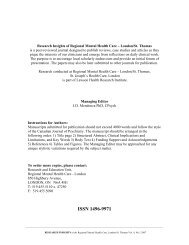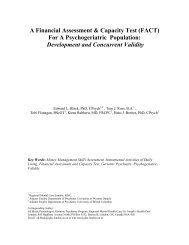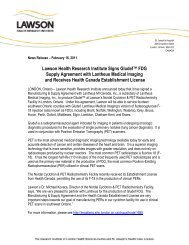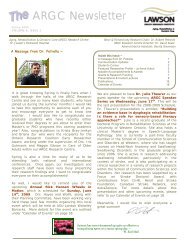REFORMS TO ONTARIO'S MENTAL HEALTH ACT: Lessons from ...
REFORMS TO ONTARIO'S MENTAL HEALTH ACT: Lessons from ...
REFORMS TO ONTARIO'S MENTAL HEALTH ACT: Lessons from ...
- No tags were found...
You also want an ePaper? Increase the reach of your titles
YUMPU automatically turns print PDFs into web optimized ePapers that Google loves.
5MGM intended to make a movie about them. Arenburg wanted this stopped and demanded that the courtresolve the problem. He said that he had sought out Prime Minister Mulroney the previous year to findout why the court had delayed resolving the issue. Arenburg stated that if the broadcasting of his thoughtsdid not stop, he would burn down the house of his ex-wife’s family or kill someone. 12Arenburg repeated these delusional beliefs while in hospital, but reportedly exhibited no other signs ofmental disorder. Arenburg’s physicians concluded that he had a paranoid psychosis. 13 Arenburg promisedto accept outpatient treatment and demanded to be discharged. He was allowed to leave hospital the dayafter he was admitted. 14In May 1991, Arenburg was admitted to the Royal Ottawa Hospital as an involuntary patient because hewas threatening to harm the staff of the CHEZ radio station. He believed that CHEZ radio staff werebroadcasting his thoughts on the radio, and he threatened to kill someone in order to bring the matterbefore a judge. Arenburg “eloped” <strong>from</strong> the hospital and went to the radio station where he talked about agovernment conspiracy and again threatened to kill the staff. 15 The police were called and returned him tothe hospital.Arenburg applied to the Ontario Civil Review Board, as it was then called, to overturn his involuntaryadmission and the finding that he was incapable of consenting or refusing consent to treatment for hismental illness. Despite being informed of Arenburg’s threats to harm the radio station staff, the CivilReview Board held that he could not be involuntarily detained. However, the Board confirmed thatArenburg was incapable of making treatment decisions. Following the ruling, Arenburg refused to remainin hospital and discharged himself against medical advice. 16 He then returned to Nova Scotia.In October 1991, Arenburg was admitted to the South Shore Regional Hospital in Bridgewater, NovaScotia for the second time. This admission followed a second incident at the local court house. Arenburgbroke windows because he was frustrated that he could not see a judge. He exhibited paranoid delusionssimilar to those he experienced during his previous admissions. Arenburg was transferred to a regional12 Arenburg (Re), No. 1437, para. 4 (Can. Ont. Review Board 2001) [hereinafter Arenburg (Re), 2001].13 Arenburg (Re), 1997, supra note 9, at 3.14 Arenburg (Re), 2001, supra note 12, para. 4.15 Id. para. 6.16 Id.RESEARCH INSIGHTS of the Regional Mental Health Care London and St. Thomas; Vol. 9, No.3, 2012




